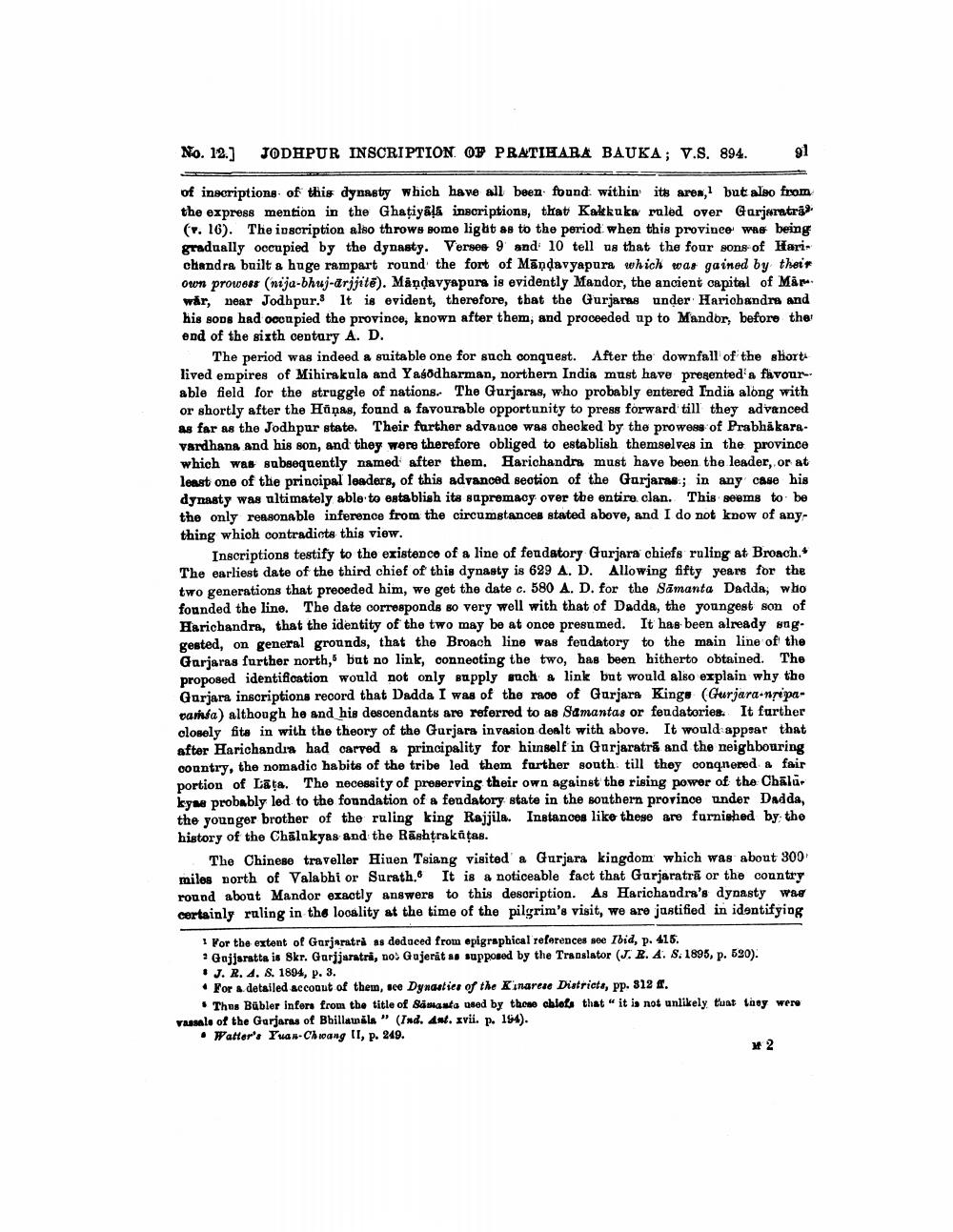________________
No. 12.]
JODHPUR INSCRIPTION OF PRATIHARA BAUKA; V.S. 894.
91
of inscriptions of this dynasty which have all been found within ith area, but also from the express mention in the Ghaţiyala inscriptions, that Kakkuka ruled over Garjuratråd (v. 16). The inscription also throws some light as to the period. when this province was being gradually occupied by the dynasty. Verses 9 and 10 tell us that the four sons of Harichandra built a huge rampart round the fort of Māndavyapura which was gained by their own prowoss (nija-bhu-arijite). Mandavyapara is evidently Mandor, the ancient capital of Mår war, near Jodhpur. It is evident, therefore, that the Gurjarne under Hariobandra and his sods had occupied the province, known after them, and proceeded up to Mandor, before the end of the sixth century A. D.
The period was indeed a suitable one for such conquest. After the downfall of the shorti lived empires of Mihirakula and Yasodharman, northern India must have presented a favour able field for the struggle of nations. The Gurjaras, who probably entered India along with or shortly after the Hūņas, found a favourable opportunity to press forward till they advanced as far as the Jodhpur state. Their further advance was checked by the prowess of Prabhakaravardhans and his son, and they were therefore obliged to establish themselves in the province which was subsequently named after them. Harichandra must have been the leader, or at least one of the principal leaders, of this advanced section of the Gurjaras.; in any case his dynasty was ultimately able to establish its supremacy over the entire clan. This seems to be the only reasonable inference from the circumstances stated above, and I do not know of any thing which contradicts this view.
Inscriptions testify to the existence of a line of feudatory Gurjara chiefs ruling at Broach. The earliest date of the third chief of this dynasty is 629 A. D. Allowing fifty years for the two generations that preceded him, we get the date c. 580 A. D. for the Samanta Dadda, who founded the line. The date corresponds so very well with that of Dadda, the youngest son of Harichandra, that the identity of the two may be at once presumed. It has been already sag. gested, on general grounds, that the Broach line was feudatory to the main line of the Garjaras further north, but no link, connecting the two, has been hitherto obtained. The proposed identification would not only supply such a link but would also explain why the Gurjara inscriptions record that Dadda I was of the race of Gurjara Kinge (Gurjara-ngipacania) although he and his descendants are referred to as Samantas or fendatories. It further closely fita in with the theory of the Gurjara invasion dealt with above. It would appsar that after Harichandia had carved & principality for himself in Gurjaratri and the neighbouring country, the nomadic habits of the tribe led them farther south till they conqnered a fair portion of Lata. The necessity of preserving their own against the rising power of the Chald. kyne probably led to the foundation of a fendatory state in the southern province under Dadda, the younger brother of the ruling king Rajjila. Instances like these are furnished by the history of the Chalukyas and the Rashtra kātas.
The Chinese traveller Hiuen Tsiang visited a Gurjara kingdom which was about 300 miles north of Valabhi or Surath. It is a noticeable fact that Gurjaratrā or the country round about Mandor exactly answers to this description. As Harichandra's dynasty wag certainly ruling in the locality at the time of the pilgrim's visit, we are justified in identifying
Vor the extent of Gurjaratra as deduced from epigraphical references se Ibid, p. 416. • Gajisratta is 8kr. Gurjjaratri, no. Gajerät as supposed by the Translator (J. R. A. 8. 1896, p. 590). • J. R. 4. S. 1894, P. 3. . For a detailed account of them, see Dynasties of the Kinarose Districts, pp. 312 .
• Thus Bübler infers from the title of Sasiasta used by these cblots that " it is not unlikely that they were Vassalo of the Garjaras of Bhillauila" (Ind. 41. xvii. p. 184).
• Watter's Yuan-Chwang II, p. 249.




